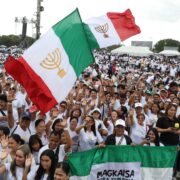Bracing for the dry spell
A line from the popular Filipino Christmas song “Himig ng Pasko” goes: “Malamig ang simoy ng hangin,” referring to the cooler temperatures during this season. But not so this year because it’s a warmer-than-usual December as El Niño continues to affect the country, especially Batangas, Cavite, and Oriental Mindoro. The dry spell is predicted to last until the second quarter of 2024 and is likely to hit almost 80 percent of the provinces.
The Philippine Atmospheric, Geophysical, and Astronomical Services Administration already raised the El Niño alert as early as March. The Bangko Sentral ng Pilipinas said this week that it will pose a grave threat to agricultural output and can affect the food supply, causing prices to further go up, and influencing interest rates. This is certainly not the best news to have this holiday season when many Filipinos are already reeling from the high prices of commodities—a reality that has dampened consumption despite the festivities and preparations for “noche buena” celebrations. Yet many have also been looking forward to the new year with optimism—the latest Social Weather Stations survey said 48 percent of adult Filipinos think that quality of life will improve in the next 12 months.
Task Force El NiñoBut Filipinos will need to brace themselves for the challenges that El Niño poses to the country next year: Science and Technology Secretary Renato U. Solidum Jr. warned that 65 out of 82 provinces will likely suffer droughts until May 2024. This will be felt in terms of agriculture and fisheries outputs raising their market prices, reduced water supply for households, as well as warmer climate that could affect public health, and if unchecked, result in the rise of tropical and food-borne diseases.
Last week, President Marcos already tasked concerned government agencies to complete water-related projects, mostly for farm irrigation and power supply, by April 2024 as part of several interventions that have been lined up to mitigate the impact of El Niño. Mr. Marcos also ordered the revival of the Task Force El Niño under the Office of the President. He assured that the government had been preparing for El Niño and that the country’s buffer stock of agricultural products could last up to the first quarter of next year.Early warning, early action systemIf, as Solidum has noted, this El Niño is “comparable” to the 1997-1998 episode that was regarded as the worst El Niño event in the world, the task force should have by now developed or rehabilitated water systems including irrigation canals, diversion dams, and small scale irrigation projects to help farmers, measures that government said it would do as early as April. It cannot afford to wait until the eleventh hour to implement these interventions when dams have dried up and the country is already facing a severe lack of water supply. In 1997-1998, about 292,000 hectares of rice and corn area were completely damaged resulting in the loss of P3 billion. Back then, authorities also had to institute water rationing in Metro Manila.
Certainly, a lot has changed over more than two decades, specifically in terms of technology. Drought monitoring and early warning systems now allow the government to take the appropriate measures to minimize the impact of extreme weather events even before they happen. During the 2018-2019 drought in Mindanao, an “early warning early action” system was set up through the Food and Agriculture Organization (FAO) to help farmers plan ahead on which alternative, short-cycle crops to plant under the dry conditions. They were provided with good quality vegetable seeds and water drums as well as resources for a women’s cooperative to set up a duck and goat farm that could augment their income and provide an additional source of food.
Anticipatory actions on the ground“Having relevant information in advance ensures enough time to launch and implement anticipatory actions on the ground. It provides time to talk to farmers, government counterparts, and local experts to find out what their needs are and build tailored plans that not only provide support but also put farmers on a stronger footing to face future shocks,” FAO said in its 2020 impact report.
Mr. Marcos has promised that the government will implement programs similar to what it did when inflation was at its peak, including the Assistance to Individuals in Crisis Situation under the Department of Social Welfare and Development, and the Tulong Panghanapbuhay sa Ating Disadvantaged/Displaced Workers or Tupad under the Department of Labor and Employment extended especially to farmers. The Department of Agriculture has also promised to help farmers by providing them with drought-tolerant and early-maturing crop varieties and organic fertilizers.
Indeed, if all these plans are properly implemented, and given the available resources and advanced technology, such early interventions can help Filipinos survive the coming dry spell.















